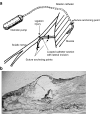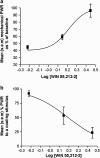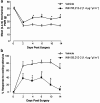Continuous infusion of the cannabinoid WIN 55,212-2 to the site of a peripheral nerve injury reduces mechanical and cold hypersensitivity
- PMID: 17375083
- PMCID: PMC2013951
- DOI: 10.1038/sj.bjp.0707210
Continuous infusion of the cannabinoid WIN 55,212-2 to the site of a peripheral nerve injury reduces mechanical and cold hypersensitivity
Abstract
Background and purpose: Cannabinoids have analgesic and anti-inflammatory properties but their use is limited by psychotropic activity at CNS receptors. Restricting cannabinoid delivery to peripheral tissues at systemically inactive doses offers a potential solution to this problem.
Experimental approach: WIN 55,212-2 was continuously delivered to the site of a partial ligation injury to the sciatic nerve via a perineural catheter connected to a mini-osmotic pump implanted at the time of injury. Bilateral reflex limb withdrawal behaviour was measured in adult male Wistar rats in response to mechanical and cooling stimulation of the hind paw.
Key results: Compared with vehicle treatment, WIN 55,212-2 (1.4 microg microl(-1) hr(-1)) reduced hypersensitivity to stimuli applied to the injured limb at 2, 4 and 6 days after injury. The effects of WIN 55,212-2 (0.6-2.8 microg microl(-1) hr(-1)) were dose-dependent. Estimated EC(50) values for reduction in mean responses to mechanical and cooling stimulation (day 4 post-surgery) were 1.55 (95% C.I, [1.11-2.16]) microg microl(-1) hr(-1) and 1.52 (95% C.I, [1.07-2.18]) microg microl(-1) hr(-1), respectively. When delivered to the contralateral side to injury, WIN 55,212-2 (1.4 or 2.8 microg microl(-1) hr(-1)) did not significantly affect nerve injury-associated hypersensitivity. Co-perineural application of a CB(1) receptor antagonist SR141716a and WIN 55,212-2 prevented the effects of WIN 55,212-2 on hypersensitivity. Co-application of CB(2) receptor antagonist SR144528 reversed WIN 55,212-2's effect on mechanical hypersensitivity on day 2 only.
Conclusions and implications: These data support a peripheral antihyperalgesic effect of WIN 55,212-2 when delivered directly to the site of a nerve injury at systemically inactive doses.
Figures







Similar articles
-
Cannabinoid subtype-2 receptors modulate the antihyperalgesic effect of WIN 55,212-2 in rats with neuropathic spinal cord injury pain.Spine J. 2010 Dec;10(12):1049-54. doi: 10.1016/j.spinee.2010.08.015. Spine J. 2010. PMID: 20920894
-
Activation of peripheral cannabinoid receptors attenuates cutaneous hyperalgesia produced by a heat injury.Pain. 2004 Jun;109(3):432-442. doi: 10.1016/j.pain.2004.02.020. Pain. 2004. PMID: 15157704
-
Cannabinoids attenuate capsaicin-evoked hyperalgesia through spinal and peripheral mechanisms.Pain. 2001 Sep;93(3):303-315. doi: 10.1016/S0304-3959(01)00336-0. Pain. 2001. PMID: 11514089
-
Activation of cannabinoid CB1 and CB2 receptors suppresses neuropathic nociception evoked by the chemotherapeutic agent vincristine in rats.Br J Pharmacol. 2007 Nov;152(5):765-77. doi: 10.1038/sj.bjp.0707333. Epub 2007 Jun 18. Br J Pharmacol. 2007. PMID: 17572696 Free PMC article.
-
Effects of SR141716 and WIN 55,212-2 on tolerance to ethanol in rats using the acute and rapid procedures.Psychopharmacology (Berl). 2007 Oct;194(2):139-49. doi: 10.1007/s00213-007-0804-1. Epub 2007 Jun 3. Psychopharmacology (Berl). 2007. PMID: 17546513
Cited by
-
Peripheral and central sites of action for the non-selective cannabinoid agonist WIN 55,212-2 in a rat model of post-operative pain.Br J Pharmacol. 2009 Jun;157(4):645-55. doi: 10.1111/j.1476-5381.2009.00184.x. Epub 2009 Apr 3. Br J Pharmacol. 2009. PMID: 19371344 Free PMC article.
-
Recent data on cannabinoids and their pharmacological implications in neuropathic pain.J Med Life. 2008 Oct-Dec;1(4):365-75. J Med Life. 2008. PMID: 20108515 Free PMC article. Review.
-
The Endogenous Cannabinoid System: A Budding Source of Targets for Treating Inflammatory and Neuropathic Pain.Neuropsychopharmacology. 2018 Jan;43(1):52-79. doi: 10.1038/npp.2017.204. Epub 2017 Aug 31. Neuropsychopharmacology. 2018. PMID: 28857069 Free PMC article. Review.
-
Cannabinoid 1 receptor knockout mice display cold allodynia, but enhanced recovery from spared-nerve injury-induced mechanical hypersensitivity.Mol Pain. 2016 May 20;12:1744806916649191. doi: 10.1177/1744806916649191. Print 2016. Mol Pain. 2016. PMID: 27206660 Free PMC article.
-
Intra and inter: Alterations in functional brain resting-state networks after peripheral nerve injury.Brain Behav. 2020 Sep;10(9):e01747. doi: 10.1002/brb3.1747. Epub 2020 Jul 12. Brain Behav. 2020. PMID: 32657022 Free PMC article.
References
-
- Ahluwalia J, Urban L, Bevan S, Nagy I. Anandamide regulates neuropeptide release from capsaicin-sensitive primary sensory neurones by activating both the cannabinoid 1 receptor and the vannilloid receptor 1 in vitro. Eur J Neurosci. 2003;17:2611–2618. - PubMed
-
- Baker D, Pryce G, Croxford JL, Brown P, Pertwee RG, Makriyannis A, et al. Endocannabinoids control spasticity in a multiple sclerosis model. FASEB J. 2001;15:300–302. - PubMed
-
- Baker D, Pryce G, Giovannoni G, Thompson AJ. The therapeutic potential of cannabinoids. Lancet Neurol. 2003;2:291–298. - PubMed
-
- Bell MR, D'Ambra TE, Kumar V, Eissenstat MA, Herrmann JL, Wetzel JR, et al. Anti-nociceptive (aminoalkyl)indoles. J Med Chem. 1991;34:1099–1110. - PubMed
-
- Beltramo M, Bernardini R, Bertorelli M, Campanella E, Nicolussi S, Fredduzzi S, et al. CB2 receptor-mediated antihyperalgesia: possible direct involvement of neural mechanisms. Eur J Neurosci. 2006;23:1530–1538. - PubMed
Publication types
MeSH terms
Substances
Grants and funding
LinkOut - more resources
Full Text Sources
Other Literature Sources
Miscellaneous

